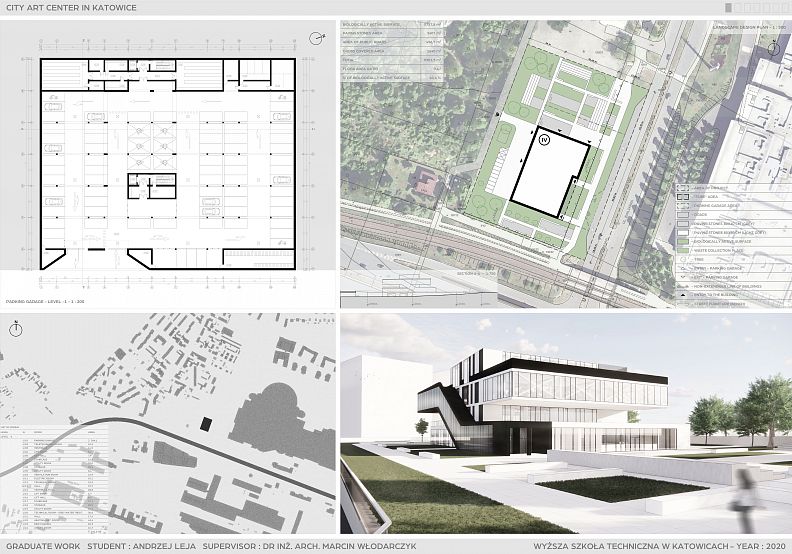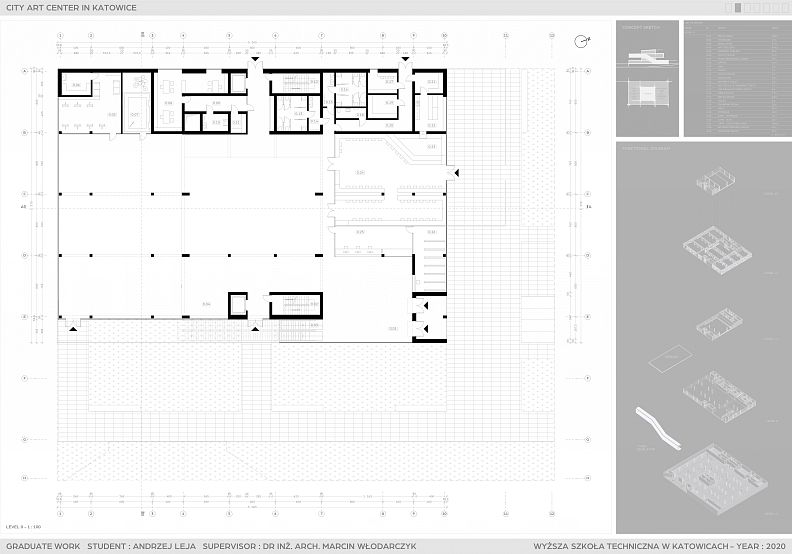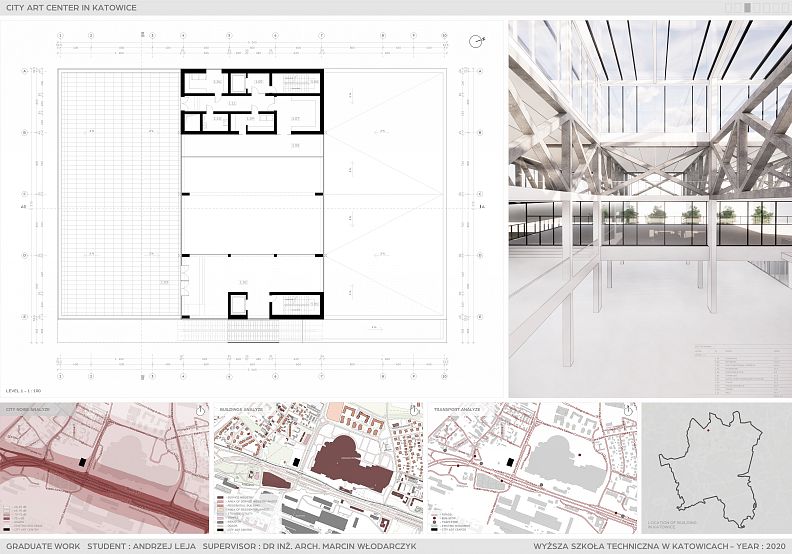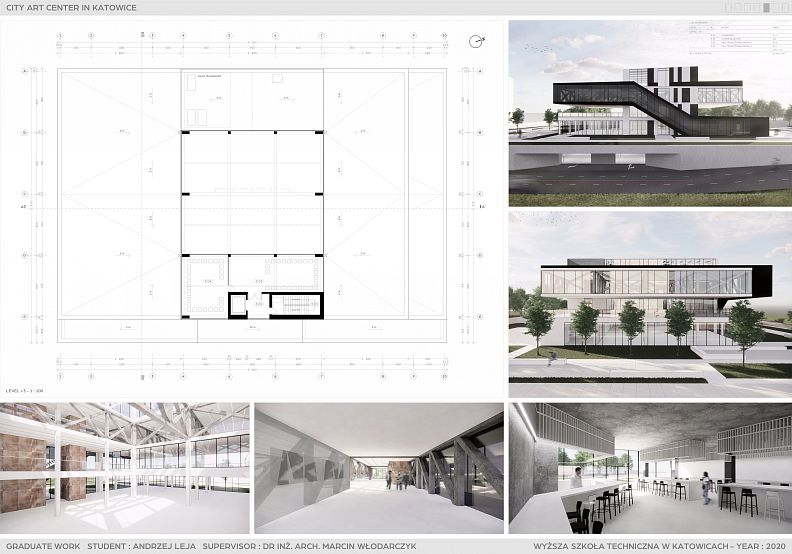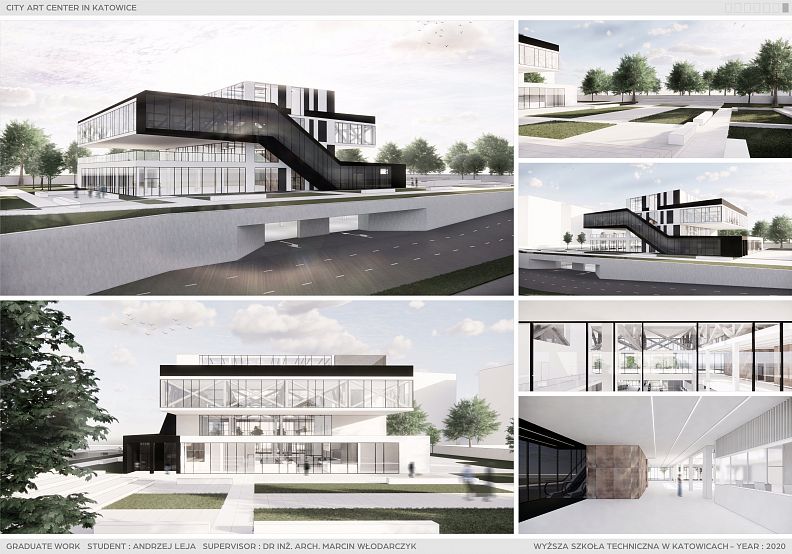City Art Center in Katowice

Idea projektu
The purpose of project was to create a multifunctional cultural building called "City Art Center in Katowice" located in the Dąb district near the former "KWK Gottwald" mine. The space is intended to be a place for the development of society and to increase its sensitivity and awareness of culture. The main idea of the project is to create a place for people to get to know together many areas of art, to spend creative and productive time and to engage in social dialog in an inspiring architectural environment besotted with everything what is creative. Thought, art, dialog, society and creativity are the essence of the idea, and the designed space is the answer to the expectations.
Popis projektu
The following project tasks are identified in the topic:
• the architectural concept of the "City Art Center in Katowice" building, which includes, inter alia:
- multifunctional spaces that can be arranged into an art gallery, meeting place, concerts or other cultural events
- a cafe with the necessary facilities
- an underground garage
- a small stage in the atrium area
- dedicated function rooms for community meetings for dialog, to address problems, cultural education and personal development
- painting atelier and the music rehearsal room
• landscape plan project for the designated development area as a public space accompanying the site
Technické informace
From the beginning, the idea of the project assumed that people would be surrounded by art, which became the first clue regarding the architectural form and functional layout. From this thought, through sketches, evolved a simple functional diagram giving the building a characteristic theme - an atrium, whose analogy was to become a connecting and common element for all above-ground floors. The binder in the area between floors has become especially the binder. Due to the fact that the repeatable and occurring element on each floor became the stems on two sides of the atrium - they assumed the function of elevator shafts, staircases (evacuation) and all rooms that are not available to general users.
The inspiration for the creation of the atrium was the function of one of the elements of the mine's landscape visible on the surface - the lift shaft, just as it was used to distribute "raw material-carbon", so the atrium in the designed building is used to distribute art to its various levels. The heart of the object is definitely the stage, which observation is possible from every level, and the sound thanks to the audio installation can appear depending on the needs in every part of the object while the events occur simultaneously.
The +2 storey has been suspended to a significant extent in order to obtain a distinct and dynamic shape, a multifunctional terrace at level +1 allowing the "exit" of the art outside the facility and to preserve the idea of the level connector in the form of a multifunctional scene.
In addition, due to some construction difficulties, it was intended to become a symbol of Silesian industry and the memory of its possibilities. There were also some elements necessary for building overhangs - steel trusses so often present in many aboveground elements of mine complexes.
The escalator was placed in a dark tube, the form of which was a direct consequence of the inspiration of the spatial element of KWK "Eminencja" mine (later KWK "Gottwald").
Its geometric form was repeated, thus becoming a characteristic element not only of the facade but of the entire form of the object.
Functional order was determined mainly by the ideas of the atrium as the center of the object and the crystallizing elements mentioned in the previous section.
The underground floor received the function of a multi-car garage and has become a location for technical and storage areas, as well as two communication shafts preceded by a fire vestibule. Entrance and exit of the underground car park was placed in a place that allows the use of the existing decline of the street Baildon. Thanks to this, there was no need to create a ramp and the entire underground floor disappears as the terrain rises, giving the facade additional fluidity and dynamism.
The ground floor is a floor intended mainly for multi-functional space, which can take many layouts and functions depending on the needs of the events taking place (it can be, among others: art gallery, place of the audience during the screening of the film on the screen behind the stage in the atrium or a space intended for concert participants or dance events). In addition, cafes were designed at this level directly accessible to pedestrians, offering ready-made products delivered from local producers in disposable, ecological packaging, which allowed to minimize its facilities and guarantee safe sanitary conditions.
The garden of this public cafe overlooks the designed public space accompanying the building, becoming its peculiar extension. Level 0 also includes, among others, music rehearsal room, art studio and rooms for employees.
The +1 floor consists mainly of two communication cores repeatable at each level, a balcony for the indoor audience, a multifunctional terrace and a stage with necessary accompanying rooms.
The multifunctional space also dominated the +2 floor, which was divided into sectors by the existing steel frame structure - an industry symbol.
The last floor consists of two separate rooms covered, like the atrium, with a steel structure filled with glass, thanks to which the interior of the building is effectively and effectively illuminated.
The building with four floors above ground and underground parking was designed in traditional technology - monolithic reinforced concrete foundation slab, underground parking foundation reinforced concrete, reinforced concrete walls above ground, reinforced concrete columns, reinforced concrete floors, monolithic. The +2 floor, due to its overhang, has been enriched with a steel structure embedded locally in reinforced concrete shafts constituting the element stabilizing the structure. Level +3 consisting of separate multi-functional rooms with a communication core was covered by a steel atrium structure filled with glass. The columns running in the axes of the structure on this floor were also designed as steel elements. The building structure, due to the occurrence in the form of overhangs, was designed as reinforced concrete, with the exception of areas located within them and the roof of the overhanging storey, where a steel frame structure was also used. Two reinforced concrete shafts as well as reinforced concrete columns and walls are load-bearing elements transferring loads from the steel structure resting on them and significantly affect the stiffening of the structure.
